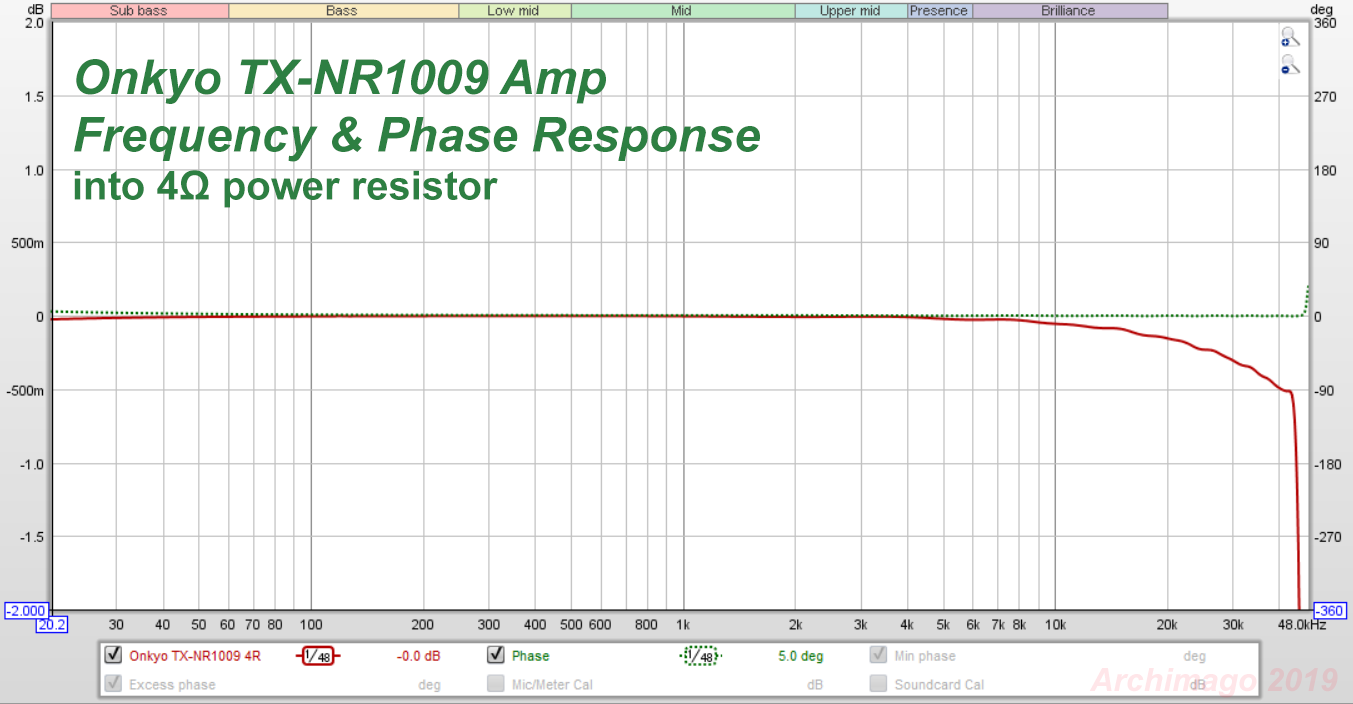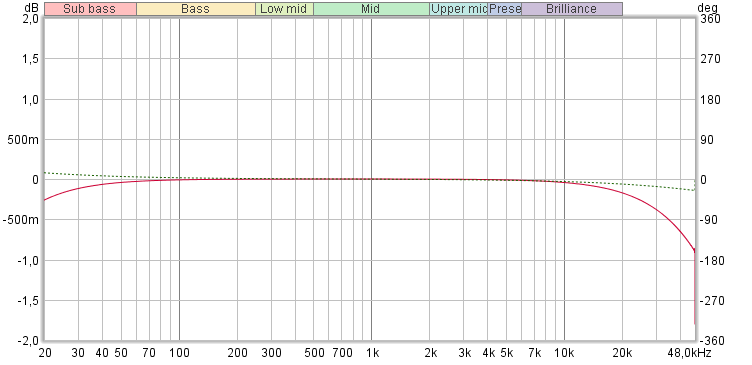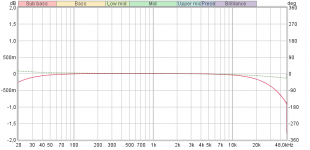Archimago's Musings: MEASUREMENTS: Onyko TX-NR1009 "WRAT" AV Receiver Class AB Amplifier... Plus Pi / LP / Resolution miscellany.


That looks great. The frequency response is flat down to 20Hz and less than 0.25dB dip into 20kHz. Notice the flat phase response from 20Hz to 48kHz characteristic of good Class AB designs.
Hi maty,
For info into linked article is written Onkyo states amp bandwidth is 5Hz-100kHz, below is 1st order textbook minimum phase of that response and means phase is aprox -11º at 20kHz point.

For me that Onkyo measurement looks not by the book or a misbehaved amplitude/phase relation even it makes you happy see zero degree at 20kHz point, speculate if its the true relation in there could be a chance the measurement chain is not 100% precise adjusted/calibrated so it drift a bit in phase, and think it could look so if you notice the the phase climb north at the very end and fade out north of zero degree but if its a 96kHz sweep then think the last fade out dot should had been down at zero degree point.
For info into linked article is written Onkyo states amp bandwidth is 5Hz-100kHz, below is 1st order textbook minimum phase of that response and means phase is aprox -11º at 20kHz point.
For me that Onkyo measurement looks not by the book or a misbehaved amplitude/phase relation even it makes you happy see zero degree at 20kHz point, speculate if its the true relation in there could be a chance the measurement chain is not 100% precise adjusted/calibrated so it drift a bit in phase, and think it could look so if you notice the the phase climb north at the very end and fade out north of zero degree but if its a 96kHz sweep then think the last fade out dot should had been down at zero degree point.
Attachments
Last edited:
Most of amp have typical issue.
It is very simple and almost common practice by sound engineer without so much knowledge about engineering:
Use same brand and design for same purpose amplifier.
If you only talks about 2 channnel stereo then you talk nothing about knowledge of phase shift
It is very simple and almost common practice by sound engineer without so much knowledge about engineering:
Use same brand and design for same purpose amplifier.
If you only talks about 2 channnel stereo then you talk nothing about knowledge of phase shift
Last edited:
The important thing is ALL amplifiers, class A, AB... or D should meet same criteria. Phase, THD+N, SNR-A...
Then it will be debatable how much is audible and according to what type of recordings.
Off topic
A very interesting new tool: Distort audibility tester | Distort documentation
Beta Test: DISTORT - audibility of distortions | Audio Science Review (ASR) Forum
Then it will be debatable how much is audible and according to what type of recordings.
Off topic
A very interesting new tool: Distort audibility tester | Distort documentation
Beta Test: DISTORT - audibility of distortions | Audio Science Review (ASR) Forum
The important thing is ALL amplifiers, class A, AB... or D should meet same criteria. Phase, THD+N, SNR-A...
Then it will be debatable how much is audible and according to what type of recordings.
Off topic
A very interesting new tool: Distort audibility tester | Distort documentation
Beta Test: DISTORT - audibility of distortions | Audio Science Review (ASR) Forum
Most of big industry move to class D
You know that all class D have higher LC component so that also bigger phase shift. Then who should follow. Standard is always adjusted as needed.
The important thing is ALL amplifiers, class A, AB... or D should meet same criteria. Phase, THD+N, SNR-A...
Then it will be debatable how much is audible and according to what type of recordings.
Rather than telling everyone to make their amplifiers measure the same so you can have a debate with yourself as to whether they are now all measure the same why don't you go away and implement an all pass filter that introduces a 180 degree phase shift variable between 5KHz and 40KHz bung it on your favourite zero phase shift amplifier and listen to the result then don't bother telling everyone there is a difference?
Class-D amps with feedback can linearize away the phase error of the filter in the audio range.Most of big industry move to class D
You know that all class D have higher LC component so that also bigger phase shift. Then who should follow. Standard is always adjusted as needed.
Nord Three SE 1ET400A Dual Mono Stereo Amp Review | Audio Science Review (ASR) Forum
Corrected results of Hypex NC400 is much worse!!!
Review and Measurements of Hypex NC400 DIY Amp | Page 10 | Audio Science Review (ASR) Forum

I have asked to amirm to measure the phase shift of the PURIFI 1ET400A:
Nord Three SE 1ET400A Dual Mono Stereo Amp Review | Audio Science Review (ASR) Forum
Maty - you do realize after this measurement was taken, it was agreed that the phase shift was affected by the AES17 filter, and later removed and remeasured, and the phase shift was more like 18 deg at 20khz (IIRC) , yeah?
It was the first time he measured the phase of a product with his AP. I guess what you said happened, I do not remember.
First: 18 degree.
After: 41 degree
18 degree maybe was acceptable, very low audible -> only bold. But 41 degree is too much, unaceptable to me, be it class A, AB, G or D.
First: 18 degree.
After: 41 degree
18 degree maybe was acceptable, very low audible -> only bold. But 41 degree is too much, unaceptable to me, be it class A, AB, G or D.
Nope. The last time I participated in one of his tests he suggested that he did not believe me, so I decided not to participate again. What is the point of lying to oneself?
Maty Tinman. Look at the dates on those graphs I posted.
First, with AES filter. 41 degrees
Second, without, as you would to speakers, 18 degrees.
First, with AES filter. 41 degrees
Second, without, as you would to speakers, 18 degrees.
The first measurement was only 18º. The second, 41º.
I would have to inquire but it is late and I am a little obtuse at this time. I prefer to get carried away by Maria-Joao Pires's piano.
I would have to inquire but it is late and I am a little obtuse at this time. I prefer to get carried away by Maria-Joao Pires's piano.
People are hearing a difference between a 100kHz and 1MHz BW preamp.
Tomorrow I will check the thread and the above.
Useful only if you have speakers that can reproduce 300khz and source recordings that contain this information.
Ever had a hearing test? According to my audiologist most people don't even get close to 20khz ... my personal hearing runs from 40hz to about 13khz ... apparently that's better than most people my age. The average in his practice is something like 50 to 14k.
To be clear, a transducer does not have to play up to 300kHz to be phase accurate up equivalent time delays of order 1/300kHz. An analogy would be an optical interferometer. It allows standard low speed electronics, and slow motion mechanical objects to resolve optical phase of the frequency of light (many many GHz). That's why phase is so useful - it can be measured to great accuracy, whereas amplitude frequency is difficult.
Good audio recordings need to preserve the phase accuracy, and this is accomplished if the recording electronics and the playback electronics and transducers, preserve the phase info, even if they only respond in amplitude to 20kHz, or even 5kHz (below which is where most of our auditory spatial imaging cues come from).
A good experiment is to take a DSP processor and distort/scramble the phase above 20kHz. Do A/B comparison with headphones to a track where you know the spatial imaging well. With the assumption that if you can't hear above 20kHz, phase distortion there should not matter. How does it sound?
Last edited:
Nope. The last time I participated in one of his tests he suggested that he did not believe me, so I decided not to participate again. What is the point of lying to oneself?
I think this is rather exaggerated or a misunderstanding. The test thread is here:
Can you hear a difference between 2 solid state preamps?
It was the first time he measured the phase of a product with his AP. I guess what you said happened, I do not remember.
First: 18 degree.
After: 41 degree
18 degree maybe was acceptable, very low audible -> only bold. But 41 degree is too much, unaceptable to me, be it class A, AB, G or D.
It is not audible if you run two channels identically and have same phase shift.
Phase shift is everywhere, from amp, cables, tranducers and the worse is passive xover.
There is missunderstanding here for how to manage phase shift in audio system. You cannot eliminate. You can only need to avoid cancellation each other channel.
Even where you stand from speaker is phase shift.
In passive xover tweeter, phase shift can be up to 150 degree. This is why most tweeter with passive xover the connection is reversed. All people in the world still enjoy the music.
If the phase shift is the same for both channels it won't affect interaural time difference. This doesn't mean that phase shift across the spectrum is not audible
- Home
- Amplifiers
- Class D
- Phase shift in class D amplifiers. How it affects the sound?
